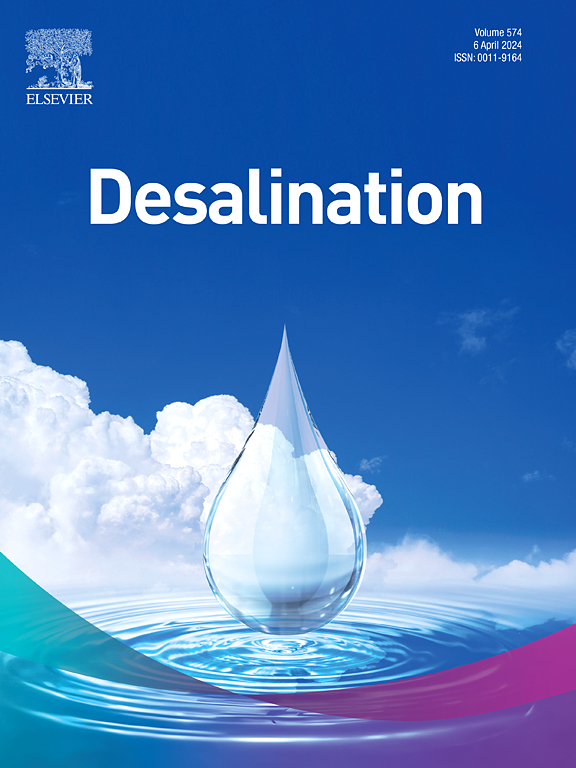利用双钠盐绿色自模板合成掺杂 P 的介孔碳,改善电容式去离子的平均孔径
IF 8.3
1区 工程技术
Q1 ENGINEERING, CHEMICAL
引用次数: 0
摘要
介孔碳材料具有广阔的可触及表面积、适应性更强的孔隙结构、优异的导电性能以及有效的表面改性和功能化,因此在电容式去离子(CDI)技术中具有巨大潜力。虽然模板法是合成介孔碳的常用方法,但其中常用的硬模板法和软模板法存在前驱体和模板剂昂贵、程序复杂、二次污染和模板去除困难等问题。相比之下,自模板法不仅避免了传统的模板去除或燃烧步骤,而且无需使用有机溶剂和危险化学品,从而最大限度地减少了对环境的影响。本文采用海藻酸钠(SA)和植酸钠(SP)双钠盐的绿色、便捷的自模板法,成功合成了平均孔径(paver)较大的掺磷介孔碳。与单一海藻酸钠(6.76 nm)或植酸钠(3.74 nm)自引发碳化法相比,采用比例混合物的双自引发碳化法获得的碳材料的平均孔径(12.97 nm)显著提高。更大的平均孔径为电极-电解质相互作用提供了更大的表面积,使离子更容易进入孔隙并加快扩散速度,从而增强了材料的电化学和电容去离子特性。这种材料的比电容为 175.8 A/g,吸附容量为 19.65 mg/g,显示出良好的电化学和海水淡化性能,突出了它在利用平均孔径较大的介孔碳材料进行电容去离子方面的应用潜力。本文章由计算机程序翻译,如有差异,请以英文原文为准。

Green self-templated synthesis of P-doped mesoporous carbon from dual sodium salts with improved average pore size for capacitive deionization
Mesoporous carbon materials hold significant potential in capacitive deionization (CDI) technology owing to expansive accessible surface area, more adaptable pore structure, excellent conductivity properties and effective surface modification and functionalization. While templating is a common method for synthesizing mesoporous carbons, the commonly used hard and soft templating approaches among them suffer from the challenges of expensive precursors and templating agents, complex procedures, secondary contaminants and difficulties in template removal. In contrast, the self-templating method not only circumvents the traditional template removal or combustion steps but also eliminates the use of organic solvents and hazardous chemicals, thus minimizing environmental impact. In this paper, we have successfully synthesized phosphorus-doped mesoporous carbon with a large average pore size (paver) using a green and convenient self-templating method employing dual sodium salts of sodium alginate (SA) and sodium phytate (SP). Compared to single SA (6.76 nm) or SP (3.74 nm) self-templated carbonization, the average pore size of carbon materials obtained from dual self-templated carbonization with a proportional mixture (12.97 nm) is significantly improved. The larger average pore size provides a greater surface area for electrode-electrolyte interactions, allowing for easier access and faster diffusion of ions into the pores, thereby enhancing the electrochemical and capacitive deionization properties of the material. The resulting material demonstrates promising electrochemical and desalination performance as evidenced by possessing a specific capacitance of 175.8 A/g and an adsorption capacity of 19.65 mg/g, underlining its potential for application in capacitive deionization utilizing mesoporous carbon materials with large average pore size.
求助全文
通过发布文献求助,成功后即可免费获取论文全文。
去求助
来源期刊

Desalination
工程技术-工程:化工
CiteScore
14.60
自引率
20.20%
发文量
619
审稿时长
41 days
期刊介绍:
Desalination is a scholarly journal that focuses on the field of desalination materials, processes, and associated technologies. It encompasses a wide range of disciplines and aims to publish exceptional papers in this area.
The journal invites submissions that explicitly revolve around water desalting and its applications to various sources such as seawater, groundwater, and wastewater. It particularly encourages research on diverse desalination methods including thermal, membrane, sorption, and hybrid processes.
By providing a platform for innovative studies, Desalination aims to advance the understanding and development of desalination technologies, promoting sustainable solutions for water scarcity challenges.
 求助内容:
求助内容: 应助结果提醒方式:
应助结果提醒方式:


